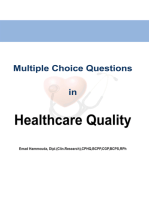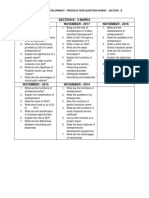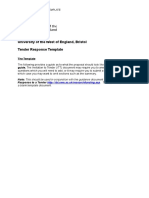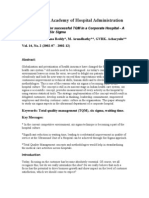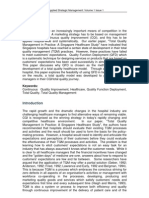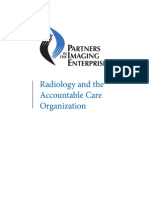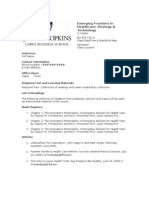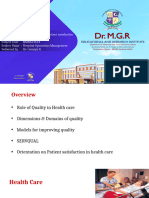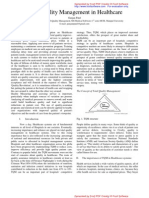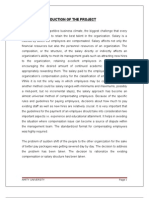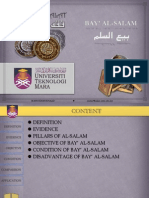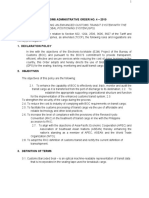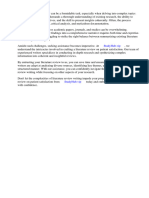Long-Term Objectives, Strategic Analysis and Choice
Long-Term Objectives, Strategic Analysis and Choice
Uploaded by
atifpfizerCopyright:
Available Formats
Long-Term Objectives, Strategic Analysis and Choice
Long-Term Objectives, Strategic Analysis and Choice
Uploaded by
atifpfizerOriginal Title
Copyright
Available Formats
Share this document
Did you find this document useful?
Is this content inappropriate?
Copyright:
Available Formats
Long-Term Objectives, Strategic Analysis and Choice
Long-Term Objectives, Strategic Analysis and Choice
Uploaded by
atifpfizerCopyright:
Available Formats
Long-term Objectives, Strategic Analysis and Choice
Table II Long-Term Objective Options Objective Aspire to be the community hospital of choice in terms of revenue. Measurement Revenue Balanced scorecard Patient mix Timelin e 2-5 years
Opportunity/Threat Improve operating margins and efficiencies. Self-pay and co-pay bad debt.
Improve operating margins and efficiencies.
Aspire to be the community hospital of choice in terms of insured customers. Aspire to be the community hospital of choice for registered nurses.
Revenue Operational statistics Balanced scorecard Turnover Employee satisfaction survey results Recruitment costs Benchmarking Balanced scorecard Balanced scorecard
2-5 years
Nurse turnover High use of agency nurses National nurse shortage Competition for nurses Re-entry of registered nurses over the age of 50
2-5 years
Increase in obesity Aging population
Aspire to be the community leader in terms of community wellness education and chronic condition management. Aspire to be the community leader in comprehensive services for mens health. Aspire to be the community hospital leader in terms of valueadded services and exemplary customer service. Aspire to be the community hospital leader in terms of a learning organization.
3-5 years
Mens health
Number of programs/services offered Balanced scorecard Market share Balanced scorecard
3-5 years
Major competitor is low-cost provider
3-5 years
Management group lacks formal management training and competencies
Balanced scorecard Turnover exceeds benchmark standards. Recruitment and retention metrics meet or exceed benchmark standards. Employee satisfaction survey
2-5 years
Increase in out-patient substitutes
Aspire to be the community hospital of choice for outpatient
Balanced scorecard
3-5 years
Trend toward outpatient surgery Aging population
procedures. Aspire to be the community hospital of choice for cardiology, neurology, orthopedics, and vascular services. Continue to be the community hospital of choice in terms of technology for earlydetection, prevention, and treatment. Balanced scorecard 3-5 years
Aging population Growing demands on healthcare
Balanced scorecard
3-5 years
As Bachrodt and Smith (2004, p. 61) point out, [t]he future market scenarioand strategic advantage/vulnerability assessment serve as a catalyst forestablishing a hospitals business objectives A thorough environmental analysis of <C>s internal and external environment revealed several potential long-term objectives and strategies with the potential to address profitability, productivity, competitiveness, employee development and relations, technical leadership and public responsibility. In addition, all of the long-term objectives are traceable to the results of the environmental analysis as can be seen in the strengths, weaknesses, opportunities and threats quadrants of the Matched Pair Analysis Matrix in Figure 2. For example, the environmental analysis indicates an increase in consumer directed healthcare that creates an opportunity for <C> to improve total revenue by targeting insured consumers. A growing demand on healthcare is another potential long-term objective identified as a threat. Public responsibility is especially critical to hospitals as community healthcare providers. Faltermayer points out [o] ne of the most promising ways to reduce health care costs is by push[ing] prevention to the limits (1994, Push Prevention). <C> is well respected as a leader in community education, and an objective of providing leadership in
preventative and early-detection technology provides <C> with an opportunity to enhance their current position and minimize future costs. One threat identified with the potential to constitute a sustainable competitive advantage is a lack of management competencies. According to one author, the only truly sustainable competitive advantage is to build an organization that is so alert and so agile that it will always be able to find an advantage, no matter what changes occur. (My Wise Owl, 2002). According to Pearce and Robinson, strategic leaders can themselves be a source of competitive advantage. This can only be achieved if their work is valuable, rare, costly to imitate, and nonsubstitutable (2004, p. 397). Opportunity exists for <C> to become a learning organization thereby creating a sustainable and nonsubstitutable competitive advantage. The most significant long-term objective option identified in the environmental analysis involves the threat of a national nursing shortage. Several of the opportunities and threats relate to the nursing shortage to a great degree placing aspiring to be the community hospital of choice for registered nurses high on the list of potential long-term objectives. Without sufficient nurses, <C> will be unable to achieve any of the objectives. Matched Pairs Analysis The SWOT and the TOWS contained with in the Matched Pair Analysis Matrix identify <C>s internal strengths and weaknesses, and the opportunities and threats derived from the external environmental analysis. The process of using the Matched Pair Analysis tool expanded the scope of the SWOT analysis and enabled the generation of an optimum number of alternative strategies for achieving the long-term objectives.
Figure 2 Matched Pair Analysis Matrix
Opportunities (O) O1 Improve operating margins and efficiency O2 Emphasis on customer service O3 Mens health O4 Consumers sharing increased healthcare costs O5 Re-entry of RNs into workforce O6 High number of nurses nearing retirement O7 Dynamic future environment O8 Trend toward outpatient surgery O9 Increase in aging population S/O/Matches S5/O5, O6 Develop recruitment and retention plan for nurses S2/O3 Provide comprehensive services for mens healthcare S6/O2 Differentiate with customer service S7/O9 Expand cardiology, neurology, orthopedics and vascular services W/O Matches W1/O1 Create payment review process W2/O5, O6 Develop recruitment and retention plan for nurses W4/
Threats (T) T1 Major competitor is lowcost provider T2 Dependence on reimbursement T3 Competition for nurses T4 Out-patient substitutes T5 Growing demand on healthcare
O/T Matches O2/T1 Differentiate with customer service O5, O6/T3 Develop recruitment and retention plan for nurses O1/T3 Pursue process redesign to improve operational efficiency O9/T5 increase capital expenditure on technology for early-detection and prevention
Strengths (S) S1 Market share 48.4 % S2 Expanding facilities and services S3 Financial health S4 Extensive purchasing alliances S5 Human resources (HR) department S6 Performance improvement department S7 Diverse services
S/T/Matches S5/T3 Develop recruitment and retention plan for nurses S6/T4 Differentiate with customer service S2/T4 Expand outpatient services
S/O/T Matches S5/O5, O6/T3 Develop recruitment and retention plan for nurses S6/O2/T4 Differentiate with customer service
Weaknesses (W) W1 Self-pay and co-pay bad debt W2 High use of agency nurses W3 Nurse turnover W4 Changing adverse business mix W5 Management group lacks management competencies
W/T Matches W1/T2 Create payment review process W3/T3 Develop recruitment and retention plan for nurses W5/T5 Create comprehensive management development program
W/O/T Matches W1/O1/T2 Create payment review process to improve cash collections, accounts receivable days, and reduce cost to collect W2/O5, O6/T3 Develop recruitment and retention plan for nurses
S/W Matches S5/W3 Develop recruitment and retention plan for nurses S3/W1 Create payment review process
S/W/O Matches S5/W3/O5, O6 Develop recruitment and retention plan for nurses S3/W1/O1 Create payment review process
S/W/T Matches S3/W1/T2 Create payment review process S5/W3/T3 Develop recruitment and retention plan for nurses S6/W4/T4 Differentiate with customer service
S/W/O/T Matches S3/W1/O1/T2 Create payment review process S5/W3/O5,O6/T3 Develop recruitment and retention plan for nurses S6/W4/O2/T4 Differentiate with customer service
Strategic Analysis and Choice Generic strategies Porter (1980; 1991) offers three generic strategic options for responding to competitive forces. His classification scheme includes: (a) a differentiation strategy whereby institutions charge more for high-quality services because of their distinctiveness; (b) an overall-cost leadership strategy where cost control allows for charging less than competitors;and (c) a focus strategy in which institutions target specific services/ buyers using either a differentiation focus or a low-cost focus (Carson & Carson, 1994, Strategy Options). Hospitals that select a low cost strategy run the risk of giving customers the perception of lower overall care. In addition, <C>s main competitor, a Catholic hospital of the same size, has a generic strategy based on low-cost and charity care. <C>s generic strategy is differentiation defined as a higher level of value, and customer and service excellence. Re-engineering, total quality improvement, scorecards, and system integration are among the internal strategies that <C> has adopted to achieve differentiation. Grand Strategies According to Pearce and Robinson (2004), a grand strategy can be defined as a comprehensive general approach that guides a firms actions (p. 200). <C> hospital is positioned in Quadrant I (strong competitive position in a rapidly growing market) of the Grand Strategy Clusters Matrix. The Model of Grand Strategy Clusters shown in Figure 3 serves as a guide to selecting a promising grand strategy (p. 250). The quadrant <C> is in places the hospital in an excellent strategic position. Quadrant I provides support that
<C> should pursue long-term objectives and strategies that focus on concentrated growth to grow and sustain the hospitals competitive advantage.
Figure 3 Model of Grand Strategy Clusters (Pearce and Robinson, 2004, p. 250).
Action Plan Action plans translate generic and grand strategies into action by incorporating specific functional tactics and actions to be undertaken ina clear time frame for completion, [that] create accountability [and in which] each actionhas one or more specific, immediate objective outcomes that action should generate (Pearce and Robinson, 2004, p. 14-15). The action plan In Table III shows a sample of some of the goals and resources that will enable <C> to achieve their strategy.
Table III Action Plan
LTO Aspire to be the community hospital of choice in terms of revenue.
Goal
Resources
Accountability
Increase outpatient services by 20% by 2009
Outpatient managers Marketing
Finance director
Aspire to be the community hospital of choice in terms of insured customers.
Create a payment process to improve cash collections and reduce cost to collect by 2007
Computer program Billing manager
Finance director
Advertising funds Marketing Finance personnel Aspire to be the community hospital of choice for registered nurses. Create incentives to delay retirement Nurse Managers Human resources
Finance director
Human Resources Nurse executives
Develop nurse refresher course
Nurse educators Community college
Education director
Aspire to be the community leader in terms of community wellness education and chronic condition management.
Develop a program to improve health of seniors
Senior services director Marketing Advertising funds
Marketing director
Statistical analysis Aspire to be the community leader in comprehensive services for mens health.
Market analysis Financial analysis
Physical space Funds Physicians Marketing Finance
Finance director
Aspire to be the community hospital leader in terms of value-added services and exemplary customer service.
Develop operational goals
Committee Time Scheduling Employee training Scheduling
Performance improvement director
Aspire to be the community hospital leader in terms of a learning organization.
Develop program designed to develop core competencies for managers Identify key competencies required for managers Perform analysis of current competencies Develop individual improvement plans
Human resources Time Materials Intranet capacity
Human resources
Develop succession plan Identify critical management positions Identify future vacancies in those positions Identify employees with potential to fit into the positions Aspire to be the community hospital of choice for cardiology, neurology, orthopedics, and vascular services.
Develop cardiovascular advisory committee Market outreach program
Physicians Cardiovascular director Cardiology nurses Scheduling changes Medical records Marketing funds
Cardiovascular director
Completing this process provides a wide variety of viable options of long-term objectives and strategies with the potential to create and sustain <C>s competitive advantage.
You might also like
- Multiple Choice Questions in Healthcare QualityFrom EverandMultiple Choice Questions in Healthcare QualityRating: 4 out of 5 stars4/5 (8)
- Tender Response TemplateDocument17 pagesTender Response Templateali50% (2)
- Case Study of Hotel Marriott in LondonDocument10 pagesCase Study of Hotel Marriott in Londonnisaa8933% (3)
- Entrepreneurial Development - Previous Year Question Papers - Section - BDocument1 pageEntrepreneurial Development - Previous Year Question Papers - Section - Bjeganrajraj60% (5)
- Shared Services For HealthcareDocument9 pagesShared Services For HealthcareNeeraj SabhnaniNo ratings yet
- Tender Response TemplateDocument17 pagesTender Response TemplateIr FasNo ratings yet
- Adv Health Economics Module - 2014 2015Document14 pagesAdv Health Economics Module - 2014 2015Matet Sales Asuncion75% (4)
- Role of Women in ManagementDocument6 pagesRole of Women in ManagementMobithermia FahrenheitNo ratings yet
- Certified Financial Planner Advisor Workbook - EnrichWise (PDFDrive)Document263 pagesCertified Financial Planner Advisor Workbook - EnrichWise (PDFDrive)Bogdana100% (2)
- Pacadi Aubmc 045012Document10 pagesPacadi Aubmc 045012Arjun KumarNo ratings yet
- Middleville Regional Health Care Is OneDocument4 pagesMiddleville Regional Health Care Is OneEli Koech100% (2)
- Organizational AnalysisDocument4 pagesOrganizational AnalysisIshban Wang'ombeNo ratings yet
- Improving Hospital Performance and Productivity With The Balanced Scorecard - 2Document22 pagesImproving Hospital Performance and Productivity With The Balanced Scorecard - 2Yunita Soraya HusinNo ratings yet
- Aco White PaperDocument37 pagesAco White PaperKatherine Wang100% (1)
- Six Sigma Approach To Health Carel Quality Management-Revised-1 by Jay Bandyopadhyay and Karen CoppensDocument13 pagesSix Sigma Approach To Health Carel Quality Management-Revised-1 by Jay Bandyopadhyay and Karen Coppensmisslopez89No ratings yet
- Health Care OverviewDocument5 pagesHealth Care OverviewMahmoud Abd ElghanyNo ratings yet
- Bench Marking of Operation Theatre ProcessDocument13 pagesBench Marking of Operation Theatre ProcessApollo Institute of Hospital AdministrationNo ratings yet
- Running Head: HEALTHCARE 1Document8 pagesRunning Head: HEALTHCARE 1Eli KoechNo ratings yet
- Payers & Providers National Edition - Issue of July 2012Document8 pagesPayers & Providers National Edition - Issue of July 2012PayersandProvidersNo ratings yet
- PDF OperationsImprovementMethods PDFDocument35 pagesPDF OperationsImprovementMethods PDFbrainNo ratings yet
- TQM in Corporate Hospitals - Using Six SigmaDocument15 pagesTQM in Corporate Hospitals - Using Six SigmaApollo Institute of Hospital Administration100% (3)
- BUS 644 Week 2 Assignment-A.randolphDocument5 pagesBUS 644 Week 2 Assignment-A.randolphAntdrone RandolphNo ratings yet
- Issue Diagnosis Memo DRAFT (Djenane Spence AndreDocument5 pagesIssue Diagnosis Memo DRAFT (Djenane Spence Andrewilgens valmyNo ratings yet
- Keywords:: International Journal of Applied Strategic Management: Volume 1 Issue 1Document14 pagesKeywords:: International Journal of Applied Strategic Management: Volume 1 Issue 1Sonika Kapoor MehrotraNo ratings yet
- Unit 10 Discussion Instructions 82774364Document3 pagesUnit 10 Discussion Instructions 82774364justin.mbaluksNo ratings yet
- Hospital Turnaround Strategies Summary & CritiqueDocument4 pagesHospital Turnaround Strategies Summary & CritiqueSahar Al-JoburyNo ratings yet
- 8 - Real Life HTADocument34 pages8 - Real Life HTAgunanti1307No ratings yet
- Literature Review Quality AssuranceDocument5 pagesLiterature Review Quality Assuranceafmzfgmwuzncdj100% (1)
- Clinical Trial ExecutionDocument5 pagesClinical Trial ExecutionSyeda Nishat Fathima TajNo ratings yet
- Balanced ScorecardDocument1 pageBalanced ScorecardRutvi Shah RathiNo ratings yet
- Quality Function Deployment in Healthcare A Literature Review and Case StudyDocument7 pagesQuality Function Deployment in Healthcare A Literature Review and Case Studyc5nr2r46No ratings yet
- Radiology Aco Whitepaper 11-18-14Document9 pagesRadiology Aco Whitepaper 11-18-14api-271257796No ratings yet
- Literature Review in Service QualityDocument6 pagesLiterature Review in Service Qualityafmzuomdamlbza100% (1)
- Business Models For Telemedicine Services A Literature ReviewDocument6 pagesBusiness Models For Telemedicine Services A Literature Reviewd0vidihujam3No ratings yet
- EDBADocument11 pagesEDBABilal SalamehNo ratings yet
- Pay-for-Performance / Quality Incentives: Discussion Paper For The MMA 623e Advisory BoardDocument10 pagesPay-for-Performance / Quality Incentives: Discussion Paper For The MMA 623e Advisory BoardAnurag PaliwalNo ratings yet
- NURS FPX 6210 Assessment 1 Care Setting Environmental AnalysisDocument7 pagesNURS FPX 6210 Assessment 1 Care Setting Environmental AnalysisEmma WatsonNo ratings yet
- King Faisal HospitalDocument11 pagesKing Faisal HospitalS S CreatingNo ratings yet
- NURS FPX 6612 Assessment 1 Triple Aim Outcome MeasuresDocument8 pagesNURS FPX 6612 Assessment 1 Triple Aim Outcome MeasuresEmma WatsonNo ratings yet
- Emerging Frontiers in Healthcare: Strategy & Technology: InstructorDocument10 pagesEmerging Frontiers in Healthcare: Strategy & Technology: InstructorPriyanka BharadwajNo ratings yet
- Management in Healthcare ReportDocument28 pagesManagement in Healthcare ReportJessica Margaux MercadoNo ratings yet
- 2023 06 20 093048PPTDocument44 pages2023 06 20 093048PPTArif ShaadNo ratings yet
- Thesis Title For Hospital AdministrationDocument7 pagesThesis Title For Hospital Administrationcynthiasmithmanchester100% (2)
- Hospitals Care Systems of FutureDocument21 pagesHospitals Care Systems of FutureAlejandro CortésNo ratings yet
- Lean ManagmentDocument20 pagesLean Managmentفيصل الاعرجNo ratings yet
- Preparing For The Next Generation of Managed Care ContractingDocument21 pagesPreparing For The Next Generation of Managed Care ContractingVaibhav RaiNo ratings yet
- Strategic Management PaperDocument19 pagesStrategic Management PaperTheddy UyNo ratings yet
- Case AnalysisDocument11 pagesCase AnalysisShuchi BhatnagarNo ratings yet
- Hospital Value-Based Purchasing PerformanceDocument18 pagesHospital Value-Based Purchasing PerformancePascalis Adhi KurniawanNo ratings yet
- How Organization Might Use Their Operations To Gain A Competitive AdvantageDocument5 pagesHow Organization Might Use Their Operations To Gain A Competitive AdvantageSHAILA JEAN TAYABANNo ratings yet
- How Much The Quality of Healthcare Costs? A Challenging Question!Document2 pagesHow Much The Quality of Healthcare Costs? A Challenging Question!Mehak KhannaNo ratings yet
- TQM in HealthcareDocument4 pagesTQM in HealthcareALtit66No ratings yet
- 26 The Balanced Scorecard of Acute Setting, Development Process, Definition of 20 Strategic Objectives and ImplementationDocument13 pages26 The Balanced Scorecard of Acute Setting, Development Process, Definition of 20 Strategic Objectives and ImplementationpilardiNo ratings yet
- Lean Healthcare Literature ReviewDocument5 pagesLean Healthcare Literature Reviewea2167ra50% (2)
- Factors That Optimise the Impact of Continuing Professional Development in Nursing_ a Rapid Evidence ReviewDocument31 pagesFactors That Optimise the Impact of Continuing Professional Development in Nursing_ a Rapid Evidence Reviewcollin sriyanthaNo ratings yet
- Introduction of The Project: Amity UniversityDocument75 pagesIntroduction of The Project: Amity UniversitysomanshshahiNo ratings yet
- HW5Document4 pagesHW5Karthik GanesuniNo ratings yet
- Foundation Program 2021-22 Case Study and Report Generation CASE - 1 (Extra) Hindustan Housing CompanyDocument5 pagesFoundation Program 2021-22 Case Study and Report Generation CASE - 1 (Extra) Hindustan Housing CompanyRaj ThakurNo ratings yet
- The Physician Value Index. A Tool For Effective Physician Integration.Document8 pagesThe Physician Value Index. A Tool For Effective Physician Integration.pscisolutionsNo ratings yet
- SM Value Chain Group 2 Assignment ReportDocument10 pagesSM Value Chain Group 2 Assignment ReportSashivNo ratings yet
- Lean Management and U.S. Public Hospital Performance Results From A National SurveyDocument17 pagesLean Management and U.S. Public Hospital Performance Results From A National SurveyArnoldYRPNo ratings yet
- Thesis Customer Satisfaction Service QualityDocument8 pagesThesis Customer Satisfaction Service Qualitygj6sr6d7100% (3)
- Strategies to Explore Ways to Improve Efficiency While Reducing Health Care CostsFrom EverandStrategies to Explore Ways to Improve Efficiency While Reducing Health Care CostsNo ratings yet
- SDO22075Document8 pagesSDO22075AnaNo ratings yet
- Parle G Marketing ProjectDocument63 pagesParle G Marketing ProjectHrdk Dve88% (8)
- Quality: A. Quality: A Management PhilosophyDocument12 pagesQuality: A. Quality: A Management PhilosophyBehbehlynnNo ratings yet
- BCom (H) 2nd Year - Cost Accounting - CSTAC - EMDocument14 pagesBCom (H) 2nd Year - Cost Accounting - CSTAC - EMRajni KumariNo ratings yet
- How To Configure Electronic Bank Statements in SAP.Document5 pagesHow To Configure Electronic Bank Statements in SAP.AnandNo ratings yet
- Akash Singh Report On Buying Behaviour of Consumer at Big BazaarDocument117 pagesAkash Singh Report On Buying Behaviour of Consumer at Big BazaarAkash SinghNo ratings yet
- FitzsimmonsMKT382Document27 pagesFitzsimmonsMKT382Carlos Delgado Nieto100% (1)
- Foundations of Information Systems in BusinessDocument6 pagesFoundations of Information Systems in BusinessshellaNo ratings yet
- Bay' Al-SalamDocument22 pagesBay' Al-SalamMahyuddin Khalid100% (2)
- Business Plan: Zephyr Computer Shop I. Business DescriptionDocument2 pagesBusiness Plan: Zephyr Computer Shop I. Business DescriptionRoque SarmientoNo ratings yet
- Application Form: (E.g. ISO 14001:2015, ISO 45001:2018 ISO 21001:2018, Etc.)Document3 pagesApplication Form: (E.g. ISO 14001:2015, ISO 45001:2018 ISO 21001:2018, Etc.)Neha UkaleNo ratings yet
- Foreign Portfolio Equity Investment in Egypt An Analytical OverviewDocument55 pagesForeign Portfolio Equity Investment in Egypt An Analytical OverviewGibran KasrinNo ratings yet
- 4Document2 pages4clarizelNo ratings yet
- Biscuit Marketing Plan ReportDocument21 pagesBiscuit Marketing Plan ReportEnglish with Syed Nafees Ahemed100% (1)
- Pdf-Xchange: Tracker Software Products (Canada) LTD - Pdf-Xchange Versions 1.X - 4.X End User License AgreementDocument2 pagesPdf-Xchange: Tracker Software Products (Canada) LTD - Pdf-Xchange Versions 1.X - 4.X End User License AgreementRichard NguyenNo ratings yet
- PS Master DataDocument107 pagesPS Master DatafatherNo ratings yet
- By Kristina Awwad Research Methods Dr. Ariana Cela Department of Business Administration, University of New York, Tirana, Albania 9 January 2023Document13 pagesBy Kristina Awwad Research Methods Dr. Ariana Cela Department of Business Administration, University of New York, Tirana, Albania 9 January 2023kristinaNo ratings yet
- BDRRMC Reso Confirming CV - SDocument3 pagesBDRRMC Reso Confirming CV - Sjeffreyparale7No ratings yet
- Business Law and RegulationsDocument14 pagesBusiness Law and RegulationsJerome CatalinoNo ratings yet
- MBA As A Learning Organization PDFDocument18 pagesMBA As A Learning Organization PDFAzim MohammedNo ratings yet
- Project Report On SiemensDocument16 pagesProject Report On SiemensArchita Maity100% (1)
- Establishing An Enhanced Customs Transit System With The Use of Global Positioning System (GPS)Document10 pagesEstablishing An Enhanced Customs Transit System With The Use of Global Positioning System (GPS)Otis MelbournNo ratings yet
- Leases - ASSIGNMENT 1Document2 pagesLeases - ASSIGNMENT 1PeachyNo ratings yet
- Sampath BankDocument8 pagesSampath BankPoornima UdeniNo ratings yet
- Review of Literature Patient SatisfactionDocument5 pagesReview of Literature Patient Satisfactioneldcahvkg100% (1)
- Solved A Bank Cashed The Checks of Its Customer Dental Supply PDFDocument1 pageSolved A Bank Cashed The Checks of Its Customer Dental Supply PDFAnbu jaromiaNo ratings yet
- EoqDocument3 pagesEoqattaurrehmanNo ratings yet
